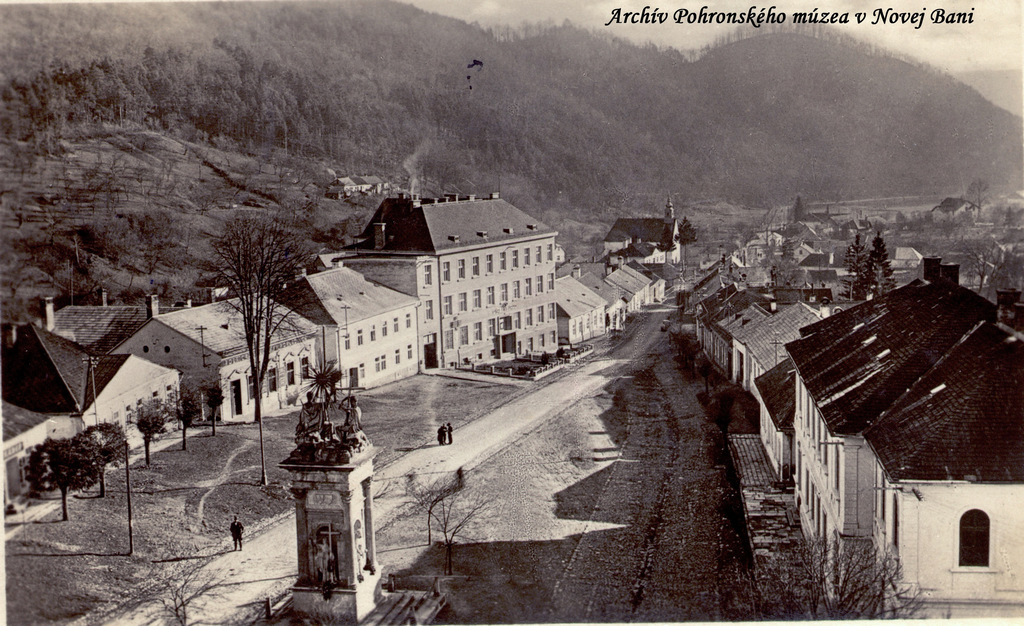The historical development of the ancient free royal mining town of Nova Bana reflects the beginning of extraction of precious metals and its gradual growth and transformation.
 The oldest traces of settlement in this locality go back to the late stone age, as is shown in the archaeological discoveries of stone axe-heads from "Mlynarov vrch" (Millers’ Peak). The well-known unique discovery of a bronze axe-head from "Janikove zeme" (Janík’s Lands) is from the middle bronze age (about 1500 BC). Proof of trade contacts in this region during the Roman period are discoveries of coins dating from the 2nd and 3rd centuries AD. "Zamcisko", located not far from Nova Bana, was part of the chain of elevated hill-forts protecting the road through the Hron River region in the restless post-Great Moravia period and in the period of the emerging Hungarian state. This extensive hill-fort, probably having the character of a shelter, was fortified by a gigantic earthen rampart and ditch which are still visible in the terrain today.
The oldest traces of settlement in this locality go back to the late stone age, as is shown in the archaeological discoveries of stone axe-heads from "Mlynarov vrch" (Millers’ Peak). The well-known unique discovery of a bronze axe-head from "Janikove zeme" (Janík’s Lands) is from the middle bronze age (about 1500 BC). Proof of trade contacts in this region during the Roman period are discoveries of coins dating from the 2nd and 3rd centuries AD. "Zamcisko", located not far from Nova Bana, was part of the chain of elevated hill-forts protecting the road through the Hron River region in the restless post-Great Moravia period and in the period of the emerging Hungarian state. This extensive hill-fort, probably having the character of a shelter, was fortified by a gigantic earthen rampart and ditch which are still visible in the terrain today.
 Some time before 1337, from which the oldest written record of the settlement Seunich – later Nova Bana – dates, miners from Pukanec ran across gold-bearing seams on this territory. From the growth in the number of mills for grinding down ore, it is possible to deduce that they were very profitable, which helped change the original hamlet into an agglomeration with a town-like character. In 1345 it obtained the status of a royal free and mining town and gradually also received privileges: the right to a market, the right of the sword, the mile right. From the viewpoint of administrative organisation, documents from the years 1345, 1346 and 1347 are proof of self-administration. Members of the town council are recorded in a mandate from Ludovit I from 8 September 1345. The foundation document, in which the borders of the town are demarcated, dates from 1355. The first document issued by the town with an attached seal is from 1348.
Some time before 1337, from which the oldest written record of the settlement Seunich – later Nova Bana – dates, miners from Pukanec ran across gold-bearing seams on this territory. From the growth in the number of mills for grinding down ore, it is possible to deduce that they were very profitable, which helped change the original hamlet into an agglomeration with a town-like character. In 1345 it obtained the status of a royal free and mining town and gradually also received privileges: the right to a market, the right of the sword, the mile right. From the viewpoint of administrative organisation, documents from the years 1345, 1346 and 1347 are proof of self-administration. Members of the town council are recorded in a mandate from Ludovit I from 8 September 1345. The foundation document, in which the borders of the town are demarcated, dates from 1355. The first document issued by the town with an attached seal is from 1348.
The greatest boom in mining and for the medieval town is recorded in the second half of the 14th century, when Nova Bana was ranked among the seven mining towns of the region of Upper Hungary. After a short period of blossom, however, the town, after being dragged into the whirlpool of internal turbulence in Hungary and the war against the Turks, experienced one wound to its fate after another – the destruction of the town by the Turks in 1664, the estate rebellions and a plague epidemic which left the town almost devoid of its population in the 17th century. The problems of ground water in the mines had a negative effect on further development of mining. The flooded mining works had to be saved by the atmospheric fire-powered machine, built in 1722 by English engineer Isaac Potter (a model of the machine is located in Pohronske muzeum (Hron Regional Museum) in Nova Bana). This was the first steam-driven machine on the European continent. In 1723 a stock company for the mining of gold was established here. Alternating successes with setbacks, the mining companies continued with their work up to 1887, when the local mines were closed due to a lack of profitability.
Since the 14th century the town was already known for its production of millstones, its artisans (potters excelled, as did shoemakers, smiths and tailors), folk woodcarvers and producers of household and agricultural tools, and its rich harvest of quality fruit.
 In 1630 one of the oldest Hungarian glassworks was established in nearby Stara Huta. More modern industry only began to develop in the year 1907 with the building of a glassworks in Nova Bana. The ancient past of the town is recalled today by several landmark buildings – the Church of the Nativity of the Virgin Mary (parish church) from the second half of the 14th century, the Church of St. Elisabeth, and the hospital from the year 1391. The 19th century bequeathed the town the classicist Church of St. Cross on the Calvary (1826), the late classicist statue group of the Most Holy Trinity (1847) and the neo-Gothic pilgrim’s Chapel of the Virgin Mary in Kohutovo (1863).
In 1630 one of the oldest Hungarian glassworks was established in nearby Stara Huta. More modern industry only began to develop in the year 1907 with the building of a glassworks in Nova Bana. The ancient past of the town is recalled today by several landmark buildings – the Church of the Nativity of the Virgin Mary (parish church) from the second half of the 14th century, the Church of St. Elisabeth, and the hospital from the year 1391. The 19th century bequeathed the town the classicist Church of St. Cross on the Calvary (1826), the late classicist statue group of the Most Holy Trinity (1847) and the neo-Gothic pilgrim’s Chapel of the Virgin Mary in Kohutovo (1863).
 Nová Baňa
Nová Baňa 
